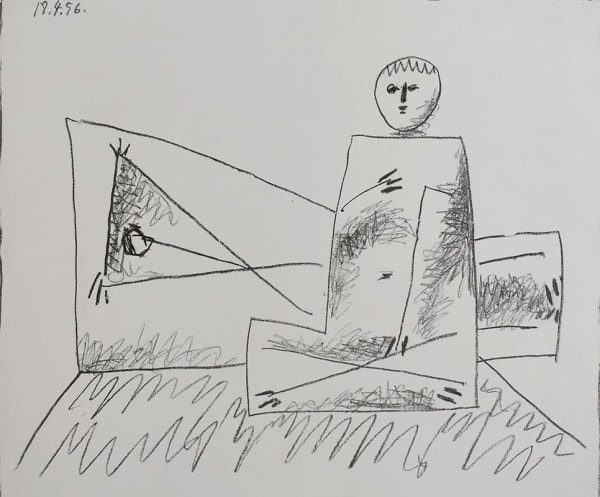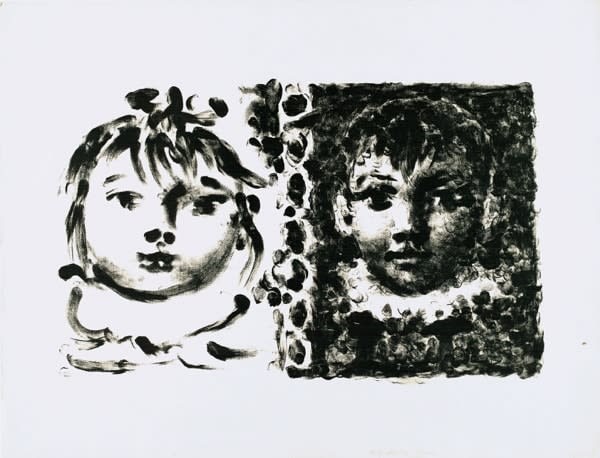
Pablo Picasso
Signed on the plate with dry editor stamp on lower left
Hand signed on lower right
53.3 x 50.8 cm
This 1901 color lithograph on Arches paper by Pablo Picasso, After the Embrace, belongs to the artist’s early period, when he was still deeply engaged with themes of intimacy, melancholy, and the emotional weight of human relationships. The work predates the radical experimentation of Cubism, yet it reveals Picasso’s emerging sensitivity to form, color, and atmosphere as tools for psychological expression.
Lithography allowed Picasso to explore a softer, more painterly mode of image-making compared to the linear sharpness of etching or drypoint. Printed on Arches paper—a high-quality French handmade paper known for its durability and subtle texture—this lithograph carries a richness of tone and delicacy of surface that complements the subject matter. The muted yet saturated palette—earthy reds, subdued blues, creamy whites, and dark browns—achieves a sense of intimacy and atmosphere, much like an oil painting translated into print. The lithographic process also enhances the blending of colors, lending the image a subdued and dreamlike quality.
In After the Embrace, a man and woman are locked in a tender yet weighted embrace, occupying the center of the composition. The figures are simplified but solid, their forms bound together by the closeness of their bodies. The man’s broad back and the woman’s leaning posture create a rhythm of diagonals, which are countered by the upright structure of the bed and chair in the background. This balance of intimacy and structural containment reinforces the sense of stillness that follows passion—the quiet moment of closeness after the act of love.
The brush-like handling of the lithographic crayon, especially in the folds of the bed and the muted wall, creates a soft, atmospheric enclosure around the couple. The subdued tonal contrasts emphasize the unity of the figures while leaving much of the surrounding space in shadow. This compositional choice directs the viewer’s attention toward the human drama rather than the setting.
Created in 1901, this lithograph coincides with the beginnings of Picasso’s Blue Period, when themes of love, loss, poverty, and existential struggle permeated his art. While not as overtly melancholic as some of his later works from that era, After the Embrace nevertheless conveys an emotional depth beyond mere representation of a romantic couple. The embrace is tender but heavy, suggesting both comfort and dependency, intimacy and weariness.
This period was also marked by Picasso’s move between Barcelona and Paris, where he absorbed influences from Post-Impressionist painters and Symbolists. The use of muted, tonal color and expressive simplification of form resonates with his exposure to Edvard Munch, Toulouse-Lautrec, and early modernist printmakers, while already signaling his own search for a more personal and emotionally charged visual language.
After the Embrace exemplifies Picasso’s early exploration of printmaking as a medium for emotional intensity. Unlike his later Cubist works that would dismantle and reconstruct form, this lithograph relies on unity, atmosphere, and color to convey psychological weight. The lithographic process, with its capacity for tonal richness and painterly nuance, becomes the perfect vehicle for expressing the quiet aftermath of passion—an embrace that is at once tender, melancholic, and deeply human.
This work foreshadows Picasso’s lifelong engagement with intimacy and desire as central themes of his art, themes he would return to repeatedly, albeit through shifting forms and techniques.
For more information or to buy After the Embrace by Pablo Picasso, contact our galleries using the form below.-
 Pablo PicassoLe Corsage à Carreaux, 1949
Pablo PicassoLe Corsage à Carreaux, 1949 -
 Pablo PicassoGrand Maternite, 1963
Pablo PicassoGrand Maternite, 1963 -
 Pablo PicassoFrançoise Sur Fond Gris, 1950
Pablo PicassoFrançoise Sur Fond Gris, 1950 -
 Pablo PicassoReclining Man and Crouching Woman | Homme couché et femme accroupie, 1956
Pablo PicassoReclining Man and Crouching Woman | Homme couché et femme accroupie, 1956 -
 Pablo PicassoThe Little Artist (Draughtsman) | Le petit dessinateur, 1954
Pablo PicassoThe Little Artist (Draughtsman) | Le petit dessinateur, 1954 -
 Pablo PicassoTete De Femme Fond Noir, 1946
Pablo PicassoTete De Femme Fond Noir, 1946 -
 Pablo PicassoBuste de Femme au Corsage Blanc (Jacqueline de Profil), 1957
Pablo PicassoBuste de Femme au Corsage Blanc (Jacqueline de Profil), 1957 -
 Pablo PicassoBuste au fond étoilé (Bust with Star Background), 1949
Pablo PicassoBuste au fond étoilé (Bust with Star Background), 1949 -
 Pablo PicassoJeu De La Cape (Bloch 1015), 1961
Pablo PicassoJeu De La Cape (Bloch 1015), 1961 -
 Pablo PicassoJacqueline Profile to the Right, 1958
Pablo PicassoJacqueline Profile to the Right, 1958 -
 Pablo PicassoLes Demoiselles d'Avignon, 1953
Pablo PicassoLes Demoiselles d'Avignon, 1953 -
 Pablo PicassoJacqueline with Roses, 1956
Pablo PicassoJacqueline with Roses, 1956 -
 Pablo PicassoPaloma et Claude, 1950
Pablo PicassoPaloma et Claude, 1950 -
 Pablo PicassoRonde de la Jeunesse, 1961
Pablo PicassoRonde de la Jeunesse, 1961 -
 Pablo PicassoFemme à la Robe
Pablo PicassoFemme à la Robe -
 Pablo PicassoProfil de Femme
Pablo PicassoProfil de Femme -
 Pablo PicassoProfil au fond noir, 1947
Pablo PicassoProfil au fond noir, 1947 -
 Pablo PicassoFemme à L'Italienne d'après le tableau de Victor Orsel (Bloch 740), 1953
Pablo PicassoFemme à L'Italienne d'après le tableau de Victor Orsel (Bloch 740), 1953 -
 Pablo PicassoGrand Nature Mort au Compotier, 1947
Pablo PicassoGrand Nature Mort au Compotier, 1947 -
 Pablo PicassoBuste, 1957
Pablo PicassoBuste, 1957 -
 Pablo PicassoPortrait de Femme II, 1955
Pablo PicassoPortrait de Femme II, 1955 -
 Pablo PicassoTête de Jeune Fille – Portrait de Françoise, 1949
Pablo PicassoTête de Jeune Fille – Portrait de Françoise, 1949 -
 Pablo PicassoJeunesse, 1950
Pablo PicassoJeunesse, 1950
Join our mailing list
* denotes required fields
We will process the personal data you have supplied in accordance with our privacy policy (available on request). You can unsubscribe or change your preferences at any time by clicking the link in our emails.
This website uses cookies
This site uses cookies to help make it more useful to you. Find out more about cookies.






















